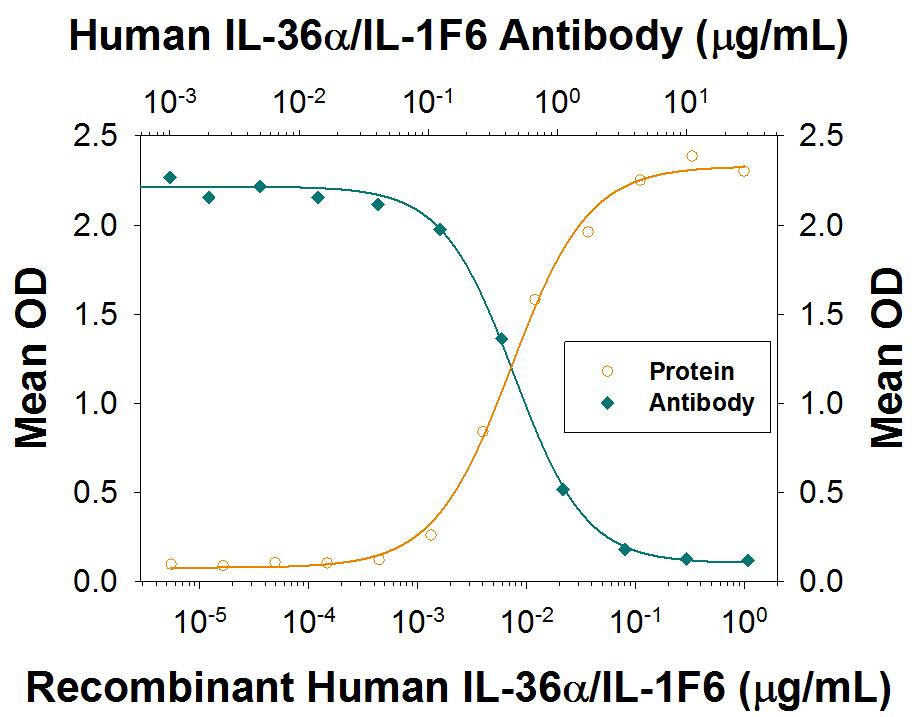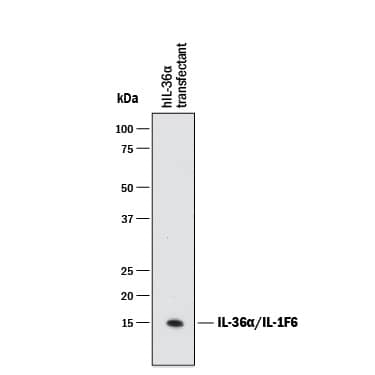Human IL-36 alpha/IL-1F6 Antibody
R&D Systems, part of Bio-Techne | Catalog # MAB10781

Key Product Details
Species Reactivity
Applications
Label
Antibody Source
Product Specifications
Immunogen
Lys6-Phe158
Accession # Q9UHA7
Specificity
Clonality
Host
Isotype
Endotoxin Level
Scientific Data Images for Human IL-36 alpha/IL-1F6 Antibody
Detection of Human IL‑36 alpha/IL‑1F6 by Western Blot.
Western blot shows lysates of HEK293T human embryonic kidney cell line transfected with human IL-36a/IL-1F6. PVDF membrane was probed with 1 µg/mL of Rabbit Anti-Human IL-36a/IL-1F6 Monoclonal Antibody (Catalog # MAB10781) followed by HRP-conjugated Anti-Rabbit IgG Secondary Antibody (Catalog # HAF008). A specific band was detected for IL-36a/IL-1F6 at approximately 15 kDa (as indicated). This experiment was conducted under reducing conditions and using Immunoblot Buffer Group 1.Il-8 Secretion Induced by IL‑36 alpha/IL‑1F6 and Neutralization by Human IL‑36 alpha/IL‑1F6 Antibody.
Recombinant Human IL-36a/IL-1F6 (aa 6-158) stimulates CXCL8/IL-8 secretion in the A431 human epithelial carcinoma cell line in a dose-dependent manner (orange line), as measured by the Human CXCL8/IL-8 Quantikine ELISA Kit (Catalog # D8000C). CXCL8/ IL-8 secretion elicited by Recombinant Human IL-36a/ IL-1F6 (aa 6-158) (80 ng/mL) is neutralized (green line) by increasing concentrations of Rabbit Anti-Human IL-36a/IL-1F6 Monoclonal Antibody (Catalog # MAB10781). The ND50 is typically 0.2-1.2 µg/mL.Applications for Human IL-36 alpha/IL-1F6 Antibody
Western Blot
Sample: HEK293T human embryonic kidney cell line transfected with human IL-36 alpha/IL-1F6
Neutralization
Formulation, Preparation, and Storage
Purification
Reconstitution
Formulation
Shipping
Stability & Storage
- 12 months from date of receipt, -20 to -70 °C as supplied.
- 1 month, 2 to 8 °C under sterile conditions after reconstitution.
- 6 months, -20 to -70 °C under sterile conditions after reconstitution.
Background: IL-36 alpha/IL-1F6
Human IL-36 alpha, previously called IL-1F6 and FIL1 epsilon (family of IL-1 member epsilon), is a member of the IL-1 family which includes IL-1 beta, IL-1 alpha, IL-1ra, IL-18, and novel family members IL-36 Ra (IL-1F5), IL-36 beta (IL-1F8), IL-36 gamma (IL-1F9), IL-37 (IL-1F7) and IL‑38 (IL‑1F10) (1‑4). All family members show a 12 beta‑strand, beta-trefoil configuration, and are believed to have arisen from a common ancestral gene (1, 2). IL-36 alpha is an 18‑22 kDa, 158 amino acid (aa) intracellular and secreted protein that contains no signal sequence, no prosegment and no potential from N‑linked glycosylation sites (1‑3). It can be released in response to LPS and the cell ATP‑induced activation of the P2X7 receptor (5). A 120 aa isoform missing aa 1‑38 has been reported (6). Human IL‑36 alpha (aa 6 ‑ 158) shares 57‑68% aa sequence identity with mouse, rabbit, equine and bovine IL‑36 alpha and 27‑57% aa sequence identity with other novel IL‑1 family members. IL‑36 alpha is mainly found in skin and lymphoid tissues, but also in fetal brain, trachea, stomach and intestine (1, 3, 7). It is expressed by monocytes, B and T cells (1, 2). The receptor for IL‑36 alpha is a combination of IL‑1 Rrp2 (also called IL1RL2 or IL‑1 R6), mainly found in epithelia and keratinocytes, and the widely expressed IL‑1 RAcP (3, 7). IL-36 alpha, beta, and gamma all activate NF-kappa B and MAPK pathways in an IL‑1 Rrp2 dependent manner, and induce production of inflammatory cytokines and chemokines such as CXCL8/IL-8 (7). IL-36 alpha and other family members are overexpressed in psoriatic skin lesions, and transgenic overexpression of IL‑36 alpha in skin keratinocytes produces epidermal hyperplasia (7‑9). IL-36 alpha is present in kidney tubule epithelia, and it is highly expressed in intubulointerstitial lesions in mouse models of chronic glomerulonephritis, lupus nephritis and diabetic nephritis (10).
References
- Smith, D.E. et al. (2000) J. Biol. Chem. 275:1169.
- Dunn, E. et al. (2001) Trends Immunol. 22:533.
- Barksby, H.E. et al. (2007) Clin. Exp. Immunol. 149:217.
- Dinarello, C. et al. (2010) Nat. Immunol. 11:973.
- Martin, U. et al. (2009) J. Immunol. 183:4021.
- Entrez Accession # EAW73614.
- Towne, J.E. et al. (2004) J. Biol. Chem. 279:13677.
- Blumberg, H. et al. (2010) J. Immunol. 185:4354.
- Johnston, A. et al. (2011) J. Immunol. 186:2613.
- Ichii, O. et al. (2010) Lab. Invest. 90:459.
Long Name
Alternate Names
Gene Symbol
UniProt
Additional IL-36 alpha/IL-1F6 Products
Product Documents for Human IL-36 alpha/IL-1F6 Antibody
Product Specific Notices for Human IL-36 alpha/IL-1F6 Antibody
For research use only

